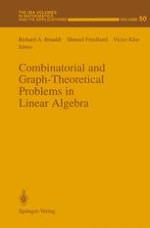1993 | OriginalPaper | Buchkapitel
Some Matrix Patterns Arising in Queuing Theory
verfasst von : Clark Jeffries
Erschienen in: Combinatorial and Graph-Theoretical Problems in Linear Algebra
Verlag: Springer New York
Enthalten in: Professional Book Archive
Aktivieren Sie unsere intelligente Suche, um passende Fachinhalte oder Patente zu finden.
Wählen Sie Textabschnitte aus um mit Künstlicher Intelligenz passenden Patente zu finden. powered by
Markieren Sie Textabschnitte, um KI-gestützt weitere passende Inhalte zu finden. powered by
A remarkably versatile dynamical system is given by $$ d{p_i}/dt = \sum\limits_{{\begin{array}{*{20}{c}} {j = 1} \\ {j \ne i} \\ \end{array} }}^n {{a_{{ij}}}{p_j} - (\sum\limits_{{\begin{array}{*{20}{c}} {j = 1} \\ {j \ne i} \\ \end{array} }}^n {{a_{{ji}}}} )} {p_i} $$ where n ≥ 2, {p1, p2,..., p n } are system variables, and {a ij } is a matrix of nonnegative real numbers. Diagonal entries in {a{ do not occur in the model in the sense that they are both added and subtracted in the given sum; for secretarial purposes we set a ii = 0. The system variables themselves arise from probabilities, so we also assume throughout that at time t = 0, all pi are nonnegative and the component sum p1 + p2 +... + p n is equal to 1.The goal of this paper is to describe the trajectories of the model in terms of a Lyapunov-like function. Doing so involves the use of theorems of Brualdi and Gersgorin, the graph-theoretic notion of balanced cycles, and the qualitative solvability of an equation involving a Hadamard product.
